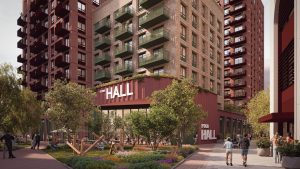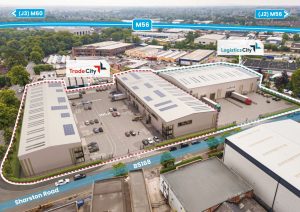
Festive Cheers from BDC: 10 Industry-Themed Ways to Get into the Christmas Spirit
As 2025 wraps up and we all prepare to blueprint a brighter, bolder 2026, the BDC team wanted to share a festive smile with our readers across the worlds of construction, development, architecture, real estate, engineering, sustainability and the countless trades keeping the UK’s built environment thriving. So, here are ten delightfully daft, industry-flavoured ways to bring a bit of Christmas cheer to your December… From all of us at Building Design & Construction, thank you for your support, your insight, and your commitment to shaping the spaces we live, work and play in. Wishing you a wonderful festive season, a well-deserved break, and a prosperous year of innovation, creativity and growth in 2026. Building, Design & Construction Magazine | The Choice of Industry Professionals

Panattoni Secures Northampton Site for £75m Brackmills Logistics Development
Panattoni has expanded its UK logistics pipeline with the acquisition of a 15-acre site at Brackmills Industrial Estate in Northampton, where it intends to deliver a speculative warehouse scheme with a gross development value of around £75 million. The site, formerly the Baxters Healthcare National Distribution Centre on Salthouse Road, will be redeveloped into a single 340,000 sq ft logistics unit known as Brackmills 340. A planning application for the project is expected to be submitted in the first quarter of 2026, with construction scheduled to start in 2028. Panattoni said the decision to bring the scheme forward speculatively reflects sustained demand in one of the UK’s most established logistics markets. Gregg Titley, Head of Development for the East and West Midlands at Panattoni, described the Brackmills opportunity as a rare chance to deliver a prime, high-quality facility in a market characterised by limited available supply. He said the site’s strategic position, strong transport links, and capacity for flexible design will appeal to both national and regional occupiers seeking sustainable, efficient accommodation. Panattoni highlighted the scheme’s planned ESG features as a key component of its offer, with the building expected to meet high environmental performance standards. The company has continued to expand its footprint across the Midlands in response to growing occupier interest in modern, well-connected distribution space. CBRE advised Panattoni on the acquisition. Building, Design & Construction Magazine | The Choice of Industry Professionals

Amro Partners Lodge Ambitious £650m Redevelopment Proposal for Lewisham Retail Park
Amro Partners has submitted a major planning application to transform Lewisham Retail Park into a large mixed-use residential neighbourhood, marking one of the most substantial regeneration proposals brought forward in the borough in recent years. The application, submitted on 4 December and currently awaiting validation by Lewisham Council, outlines the full redevelopment of the 2.8-acre site on Loampit Vale, which Amro acquired earlier this year. The plans set out a £650 million scheme comprising five new buildings and close to 2,000 square metres of commercial floorspace. The development would deliver 387 Build-to-Rent homes, 383 co-living studios and 682 student rooms, creating a total of 1,452 residential units. Discussions are said to be under way with specialist food hall operators to take up 1,000 square metres of the proposed commercial space. The Build-to-Rent homes would include one to three-bedroom flats, with layouts intended to accommodate single residents through to larger households of up to six people. Affordable housing levels have yet to be agreed with the council, though the intention is for the scheme to incorporate a blend of social rent and discounted market rent homes. Public realm improvements form a substantial part of the proposals, with plans for two residential garden areas and a central square featuring seating, children’s play spaces, open lawns, walking and cycling routes, and almost 100 new trees. Amro said the aim is to create a vibrant, inclusive environment to support long-term community life. Raj Kotecha, chief executive and co-founder of Amro Partners, described the proposals as a once-in-a-generation opportunity to reshape the site into a new sustainable neighbourhood. He said the team had spent months engaging with local people to help inform the vision and ensure the development delivers meaningful social, environmental and housing benefits. The site was previously owned by Legal & General, which secured consent in 2018 for a residential-led scheme that was never brought forward. If Amro’s plans are validated, they will move into the formal decision-making process, including public consultation and eventual consideration by either a planning officer or planning committee. Should planning permission be granted, Amro anticipates beginning construction in early 2027, with phased completion expected through 2029 and 2030. The scale of the proposals sits alongside other major regeneration activity in the area, including Landsec’s £1.5 billion redevelopment of Lewisham Shopping Centre, approved in October, which will deliver 1,744 homes alongside student accommodation and co-living units. Building, Design & Construction Magazine | The Choice of Industry Professionals

Kier Property Advances £26m Sharston Industrial Redevelopment
Kier Property is moving ahead with the transformation of a key site in Sharston after completing demolition works and securing planning approval for its new Trade City and Logistics City scheme. The four-acre site, purchased earlier this year from Electrium, a Siemens subsidiary, is now ready for the construction phase, which is scheduled to begin in early 2026. The redevelopment will deliver close to 100,000 sq ft of modern employment space, replacing ageing industrial units that had reached the end of their operational life. The scheme comprises eight Trade City units ranging from 5,391 to 11,664 sq ft, designed to accommodate small and medium-sized enterprises, trade counters and light industrial occupiers. In addition, a single Logistics City building of 34,584 sq ft will offer contemporary space for operators requiring efficient layouts and strong transport connectivity. Kier has delivered similar schemes elsewhere, including one completed in late 2024, which brought forward a further 94,000 sq ft of new industrial accommodation. The company said the Sharston project will help address ongoing demand for high-quality space within an established commercial area. Leigh Thomas, group managing director at Kier Property, said the completion of demolition and positive planning outcome marked a significant milestone. He added that the new development would provide modern, sustainable premises for occupiers seeking well-connected locations with access to key markets. Savills and JLL have been appointed as joint agents for the scheme. Alex Palfreyman, director at Savills, said the project represents a timely addition to a supply-constrained industrial and trade counter market, offering new options for businesses seeking space in the area. Design work is being led by Horizon Fletcher Rae, while Savills is also advising on planning matters. Full details of the project can be found on Manchester City Council’s planning portal under reference number 143771/FO/2025. Building, Design & Construction Magazine | The Choice of Industry Professionals

Aldi Ramps Up Expansion with Five Store Openings in Just 24 Hours
Aldi has marked a major milestone in its ongoing UK growth push after opening five new stores within the space of 24 hours across 11 and 12 December. The new branches are located in Uxbridge, Northallerton, Pershore, Old Kent Road in London, and Yate in Bristol, significantly increasing the retailer’s reach in the run-up to Christmas. The openings form part of Aldi’s long-term ambition to operate 1,500 UK stores, up from its current total of around 1,070. The supermarket has outlined a substantial investment plan to support this expansion, including £650 million allocated for store launches and refurbishments in 2025, and a further £1.6 billion committed over the following two years. Jon Neale, real estate managing director at Aldi UK, said the rapid series of openings highlights both the retailer’s momentum and the strong demand from customers for more local access to its offer. He added that launching five stores in the days leading up to Christmas will provide a timely boost to shoppers in each of the newly served areas. Neale emphasised that Aldi remains focused on expanding in locations where it can make the greatest positive impact, supported by teams that deliver its value-focused approach. He said the retailer is moving at pace to bring its combination of low prices and high-quality products to more communities across the country. With the latest openings completed, Aldi’s expansion drive shows no sign of slowing as it continues to target new sites and broaden its national footprint heading into 2025 and beyond. Building, Design & Construction Magazine | The Choice of Industry Professionals

Types of Safety Boots and How to Choose the Right One for Your Job
Foot injuries contribute to a huge number of lost workdays in various industries. This makes choosing the right safety and working boots from RS a key part of work safety and compliance, as it helps prevent serious injuries. When well chosen, these boots go beyond safety, as they enable workers to move, lift, and focus on the task at hand without worrying about things like slipping or chemical exposure. However, they also come in a wide variety, as they are used in multiple industries and different environmental conditions. This makes choosing the right type a key part of safety, compliance, and productivity. Why safety boots are important In most cases, professionals come to appreciate work boots as part of personal protective equipment (PPE) when they are working in a risky environment. These are more than just foot covers, as they act as a worker’s first line of defence against environmental hazards. The boots can absorb impact, keep out unwanted elements, and provide grip when you need it most. But that’s just one aspect of work boots. Higher-quality safety wear is designed to reduce fatigue and support a worker’s posture, which helps them move with confidence. Things like walking, bending, lifting, and climbing become much safer and less exhausting. How to choose the right safety boots for your job To pick the right safety boots, you need to match the type of footwear to the specific risks and demands you or your workers face. Is it heavy objects that can drop on the feet, sharp objects that can puncture the sole, or wet and muddy conditions? This consideration also goes hand in hand with environmental factors like cold conditions and electrical hazards. Fit and comfort are also important, as a boot that’s too tight or too loose can lead to issues like fatigue, blisters, or even long-term foot and joint issues. There’s also the durability aspect, but this one is more about using the right shoe for the job and environment. Main types of safety boots To choose the right safety boots, you first need to understand the different types available and what each of them is designed to protect against. Steel-toe boots These boots usually have a reinforced steel cap over the toes. They are designed to protect a worker from impacts, falling objects, and compression. They are the shoes that are most common in warehouses and are a major part of construction site safety. But while the toes provide much-needed protection, they also make the shoes a bit heavier than other options. You also need to ensure that they are a proper fit and have proper cushioning. Composite-toe boots These are also meant to offer extra protection to toes, but they use non-metal materials for the same purpose. Some common ones are carbon fibre, Kevlar, and hard plastic. The materials used make them lighter than steel-toe boots, and the lack of metal is also useful in workplaces that use metal detectors or where there are risks of electrical hazards. Safety trainers These ones look and actually feel more like athletic shoes. However, they have several protective features like reinforced toes, anti-slip soles, and puncture resistance. They are mostly meant to be used in light-duty work and indoor environments. You can use them when you need to ensure worker mobility and comfort, besides protection. They are mostly used by warehouse staff, logistics teams, or technicians who need to move around to ensure everything is working well. Wellington boots These are mostly meant to offer protection against water. They tend to be high-cut and are made from rubber or PVC. Some also have reinforced toes. Wellies, as they are often called, are mostly used in agriculture and food processing. Insulated or thermal boots This type is designed for cold or extreme environments. They are mostly meant to provide heat, so they often have layers of insulation and don’t allow water to enter. The boots are particularly useful in winter and when working in cold storage facilities, as workers can be exposed to freezing temperatures for extended periods. The boots will keep their feet safe from frostbite and discomfort but also not cause excessive sweating.

